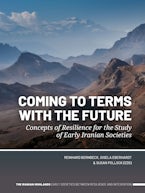The period c. 10,000-5000 BC witnessed fundamental changes in the human condition with societies across the Fertile Crescent shifting their alignment from millennia-old practices of seasonally mobile hunting and foraging to year-round sedentism, plant cultivation and animal herding. The significant role of Iran in the early stages of this transition was recognized more than half a century ago but has not been to the fore of academic consciousness in recent decades. In the meantime, investigations into Neolithic transformation have proceeded apace in all other regions of the Fertile Crescent and beyond. Here, 18 studies attempt to redress that balance in reassessing the role of Iran in the early neolithisation of human societies.
These studies, many of them by Iranian scholars, consider patterns of change and/or continuity across a variety of topographical landscapes; investigate Neolithic settlement patterns, the use of caves, animal exploitation and environmental indicators and present new insights into some well-known and some newly investigated sites. The results reaffirm the formative role of this region in the transition to sedentary farming.
1. The Neolithisation of Iran: Patterns of Change and Continuity (Hassan Fazeli Nashli and Roger Matthews)
2. Investigating the Neolithisation of Society in the Central Zagros of Western Iran (Roger Matthews, Yaghoub Mohammadifar, Wendy Matthews and Abbass Motarjem)
3. Neolithic Settlement Patterns of the Sarfirouz Abad Plain, Central West Zagros (Kamal Aldin Niknami, Meisam Nikzad and Sajjad Alibaigi)
4. Tappeh Sarab-e Yavari: A Neolithic Site with Tadpole Ware on the Kermanshah Plain, West Central Zagros (Sajjad Alibaigi)
5. The Neolithisation Process in the Seimarreh Valley: Excavations at East Chia Sabz, Central Zagros (Hojjat Darabi, Hassan Fazeli Nashli, Reza Naseri, Simone Riehl and Ruth Young)
6. Revisiting Neolithisation in the Zagros Foothills: Excavations at Chogha Golan, Pre-Pottery Neolithic site in Ilam Province, Western Iran (Nicholas J. Conard, Simone Riehl and Mohsen Zeidi)
7. Proto-Neolithic Caves and Neolithisation in the Southern Zagros (Akira Tsuneki)
8. The Neolithisation of Fars, Iran (Lloyd Weeks)
9. Tepe Rahmatabad: a Pre-Pottery and Pottery Neolithic Site in Fars Province (Hossein Azizi Kharanaghi, Hassan Fazeli Nashli and Yoshihiro Nishiaki)
10. Mapping the Neolithic Occupation of the Kashan, Tehran and Qazvin Plains (Hassan Fazeli Nashli, Robin Coningham, Armineh Marghussian, Mark Manuel, Hossein Azizi Kharanaghi and Mark Pollard)
11. Tepe Khaleseh, a Late Neolithic Site in Zanjan Province (Hamid Reza Valipour, Hossein Davoudi, Iman Mostafapour and Anna Gręzak)
12. Animals and People in the Neolithisation of Iran (Hassan Fazeli Nashli and Ruth Young)
13. Sediments, Soils and Livelihood in a Late Neolithic Village on the Iranian Plateau: Tepe Sialk (Nikos Kourampas, Ian A. Simpson, Hassan Fazeli Nashli and Robin Coningham)
14, Tappeh Sang-e Chakhmaq: Investigations of a Neolithic Site in Northeastern Iran (Seiichi Masuda with Ken Gotō, Takuya Iwasaki, Hitoshi Kamuro, Setsuo Furasato, Jirō Ikeda, Akira Tagaya, and Masayo Minami and Akira Tsuneki)
15. Tappeh Sang-e Chakhmaq: A New Look (Christopher P. Thornton)
16. Northeastern Iran in the Neolithic: the Site of Pookerdvall (Rouhollah Yousefi Zoshk and Majid Zeighami)
17. The Late Neolithic Site of Rashak III Rock Shelter, Mazandaran, Iran (Hamed Vahdati Nasab, Christopher P. Thornton, Seyed Mehdi Mousavi Kouhpar, Naomi Sykes and Rahmat Naderi)
18. Tell-e Atashi (Bam, Southeastern Iran) and the Neolithic of the Eastern Near East (Omran Garazhian and Maryam Shakooie)











